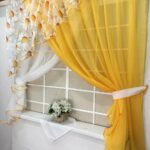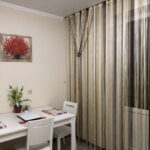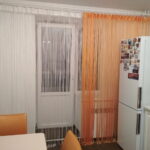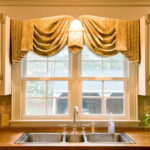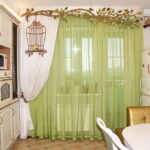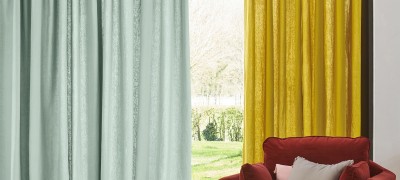How to sew curtains for the kitchen with your own hands
Sewing an original curtains for the kitchen with your own hands is not some super complicated event. The most important thing is to decide on the color, type and size of the fabric. In a small kitchen, you can get by with classic short curtains; for a large kitchen-studio, you should consider the option of sewing curtains to the floor. The length of the curtain also depends on the layout of the kitchen - if the window is next to a sink or stove, then it is better to sew a short curtain, and when decorating a window in the dining area, you can give freedom of imagination.

Note! Kitchen curtains should be both beautiful and practical at the same time. They will have to be washed several times throughout the year, so the curtains should be easy to remove and hang back.
The choice of fabric for curtains in the kitchen
A wide variety of fabrics can be used to make kitchen curtains. But, it should be borne in mind that not all materials are suitable for the kitchen. Ideally, the kitchen curtain should not absorb odors, moisture, fade in the sun, collect dust and electrify.
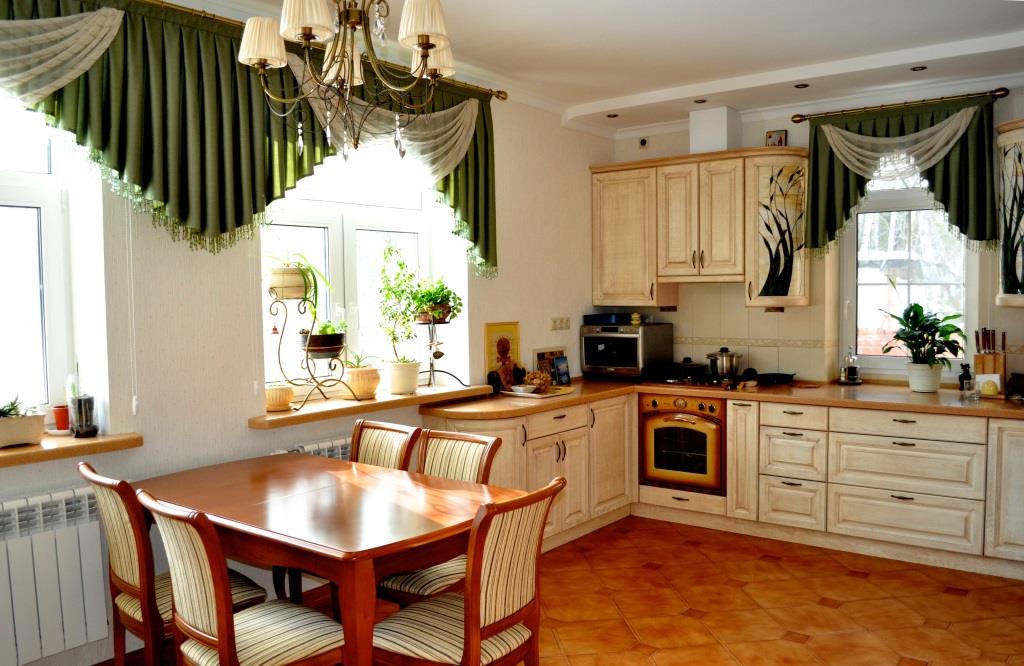
Since the ideal fabric has not yet been invented, the most popular materials for kitchen curtains are:
- Cotton is one of the most common natural materials. Cotton fabrics are excellent for heat and air permeability, and are easy to wash. If you wish, you can choose a color and pattern for almost any interior option. The only but very serious drawback is that cotton fabrics fade very quickly, losing their presentability.
- Linen is another popular natural material that, unfortunately, cannot boast of the ability to maintain its color gamut for a long time under the influence of sunlight.
- Silk - rarely used in the kitchen, because it quickly becomes dirty and wrinkled. The only exception is the curtains for the windows in the dining area of the large studio kitchen.
- Viscose is a man-made fabric that resembles silk and cotton in appearance. Does not fade in sunlight, but wrinkles and is not highly durable.
- Acetate is an elastic material that resembles silk. Does not fade, does not wrinkle, is easy to clean, but very electrified.
- Synthetic fabrics (polyester, acrylic) are durable, but they do not allow air to pass through and do not tolerate high temperatures during washing and ironing.
If we evaluate fabrics in terms of density and light transmittance, then they can be divided into curtain (satin, brocade) and tulle (tulle, organza, chiffon, veil).
Note! Depending on the size of the kitchen and its layout, the curtain can act as an element that complements the interior or is its main accent. It is often very beneficial that a beautiful curtain catches the eye when entering a room, and not furniture, household appliances or kitchen utensils.
Calculation of the amount of material
In order to correctly calculate the amount of fabric required for sewing a curtain, you should decide on its width and length.The width is usually equal to the width of the eaves. If the curtain is assembled, then it is necessary to multiply the expected width by the assembly factor (for curtain fabric it is 1.7, for a veil - 2, for a thin monochromatic organza - 3).

The following options are possible in length:
- to the window sill - the curtain does not reach about 1 cm to the plane of the window sill;
- below the window sill - the curtain overlaps the window sill by 10 - 15 cm;
- to the floor - the lower edge of the panel rests on the floor or does not reach it by 1-1.5 cm.
Another nuance - when calculating the amount of fabric, you must take into account the standard width of the rolls. Most types of tulle and voile are sold in rolls from 2.8 m wide, while curtain fabrics are available in three standard widths - 1.4 m, 2.8 m and 3.0 m.

In order not to be mistaken with the size of the required material, you must first fix the cornice, which will become the zero reference point and do not forget about the allowances for fabric processing (about 10 cm). When buying fabric with a repeating pattern (rapport), the calculated length should be increased by the size of the rapport. The leftover fabric can be used for grabs or small pillows.

Note! When carrying out all measurements, it is advisable to use not the usual centimeter, but a metal tape measure, which is more accurate.
Design and original ideas
On the Internet, you can find a lot of original ideas and findings on the design of window openings. Home craftsmen and professional designers use a variety of materials, creating real masterpieces, and sewing curtains for the kitchen with their own hands becomes a favorite hobby for many.
Creative curtains for the kitchen from towels
Towel fabric can be washed very well, retaining its original appearance for a long time. And a rich selection of colors allows you to sew a curtain from towels that will organically fit into almost any kitchen interior.

Sewing curtains for the kitchen from old tulle
The old tulle from the living room can get a second life as kitchen curtains or curtains. You can also combine it with new and used curtains.

Sheet curtain
At first glance, bedding has absolutely nothing to do in the kitchen. However, as practice shows, the idea to curtain the window with a sheet looks very original and practical.

Knitted curtains for the kitchen - a new life of an old idea
Knitted curtains do not pretend to be opening. They have been used for quite a long time in the design of window openings and only confirm that everything new is a well-forgotten old. Today, this unconventional way of decorating windows is again popular and in demand.

Patterns of curtains for the kitchen for self-tailoring for beginners
Taking up sewing curtains in the kitchen with your own hands, photos from the Internet can be taken as a basis and a sample. But, it is absolutely not necessary to mechanically copy someone's ideas, they can and should be refined and improved. There can be a lot of creative options for the development of already created projects.

In the patterns of curtains for the kitchen downloaded from the Web for self-tailoring for beginners, as well as in numerous videos with step-by-step instructions, you can find a lot of useful information. It is noteworthy that both the patterns and video tutorials can be downloaded for free. At the same time, in addition to the pleasure of the process and the result of your work, you can seriously save money, because buying a ready-made beautiful and high-quality curtain is not a cheap pleasure.
Open the loops
The use of fabric loops for fixing the curtain to the eaves is becoming more and more popular. Having decided to sew kitchen curtains with your own hands according to patterns with step-by-step photos, you will definitely find detailed recommendations for cutting loops. They are most often made from the same fabric as the curtain, but if you wish, you can take any fabric, experiment with different shades and try to make the window decoration more elegant.

Most often, the following types of loops are independently made:
- rectangular (the simplest option);
- narrowed at the point of connection with the panel (a little more difficult to manufacture, but look more impressive);
- in the form of a bow or a butterfly (require more fabric consumption and time to manufacture).
A simpler option is to make loops from braided threads. In this case, various color options are also possible. When forming the pigtail, it should be remembered that it should not be very thick, since it should easily cling to the cornice hook.

Note! When calculating the number of fabric loops, keep in mind that the curtain will look more elegant if the distance between the loops is slightly greater than their width.
Sewing the basics
It is recommended to wash and iron the fabric before cutting and sewing the base of the curtain. This will avoid shrinkage in the finished product.
The step-by-step instructions for obtaining the base of the curtain are as follows:
- Lay out the cut fabric with the wrong side up.
- Finish the side seams (turn 2 cm twice and iron and sew).
- Finish the bottom edge (tuck in 5 cm twice and iron and sew)
- Turn fabric right side up.
- Place a tape under the upper cut, wrap it 1.5 cm with a cloth and sew. Pay attention to the fact that the tape is not visible from the front side.
- Form folds (if necessary) by tightening the laces on the ribbon.

Decorating
Elements for decorating a kitchen curtain are selected depending on its type, size and design of the room. Among the most popular finishes are:
- textured braid;
- bows and hooks;
- tassels and fringes;
- flowers;
- beads;
- decorative magnets;
- embroidery and appliques.
Video: how to sew curtains yourself








